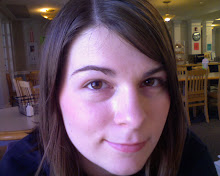The Rare Books and Manuscripts Room in the BPL is tucked away behind a gallery space and through the Art and Music section of the library. I thought I would never arrive but old, worn hand-painted signs told me I was headed in the correct direction. I eventually made it to a serene dimly lit room, lined with glass cases that were full of old books.

After filling out some paperwork I was finally buzzed into the reading room and the librarian behind the desk showed me the books that had been pulled, waiting for me on the table. I had no idea the manuscript was so huge--literally, over 2 feet tall and with each page more than a foot and a half wide with heavy leather covers and vellum pages. To the right you can see the Latin Vulgate next to one of the volumes of the Biblia Sacra (a thick book as well, but dwarfed in the presence of the medieval beast next to it). The cover is adorned with metal and has leather straps to keep it closed. Along the bottom are metal spikes and there are also metal bars to support the pages when the book is open and propped up (presumably in front of the choir or congregation). It's an absolutely gorgeous book and it was an amazing experience to open it and turn the thick pages for myself, pages that were painted and written on over 500 years ago.
To the left is a photo of the historiated initial of my assigned Psalm (5). The text is almost entirely composed of abbreviations, with very few full words. Given the size of the text, this makes perfect sense since if the words were written out the book probably would be quadruple its current length. Also, since it was written and illustrated by hand, a longer text would obviously require more time to write.
As you can see, the illustrations and writing are in beautiful condition. Some pages are more faded than others, but almost all the illuminations are equally vivid and crisp.
I've never been terribly interested in Medieval books, although I think illuminated manuscripts are wonderful pieces of art. However, this was an amazing experience--a million times better than seeing a manuscript in a museum (and--horrible as this sounds coming from an Art History student--even I have to admit that museums can be very dull places). Being able to open the covers, turn the pages, and look closely at the illuminations is an experience that I wish all people could have. I'm sure it would promote far more respect and admiration for the past, and for books in general, if everyone could have such an intimate experience, bridging hundreds of years and brushing their fingertips over the very same pages that human hands constructed centuries ago, hands not so different from our own.
As you can see, the illustrations and writing are in beautiful condition. Some pages are more faded than others, but almost all the illuminations are equally vivid and crisp.
I've never been terribly interested in Medieval books, although I think illuminated manuscripts are wonderful pieces of art. However, this was an amazing experience--a million times better than seeing a manuscript in a museum (and--horrible as this sounds coming from an Art History student--even I have to admit that museums can be very dull places). Being able to open the covers, turn the pages, and look closely at the illuminations is an experience that I wish all people could have. I'm sure it would promote far more respect and admiration for the past, and for books in general, if everyone could have such an intimate experience, bridging hundreds of years and brushing their fingertips over the very same pages that human hands constructed centuries ago, hands not so different from our own.


No comments:
Post a Comment